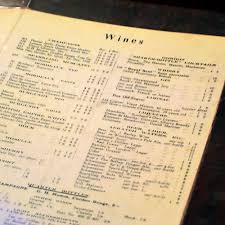
Many people have written to me over the years expressing their dismay at the sorry state of restaurant wine. Usually they complain about high restaurant prices and ask how they can possibly be justified. They are seldom satisfied with my answer — restaurants charge high prices because people will pay them. Now, however, the critique has shifted to the wines themselves and what they reveal about wine in America.
What Does American Really Drink?
My recent post on “Olive Garden and the Future of American Wine” (see previous post) seemed to catch many wine enthusiasts by surprise. It reported data from Restaurant Wine magazine for the best-selling wines in American restaurants as determined by distributor “on-premises” shipments. This data, based on volumes shipped to all “on-premises” establishments in 2008, reveals that when America goes out it drinks a lot of White Zinfandel, Pinot Grigio and (gasp!) “Chablis.” Only one red wine made the top 20 list: Yellow Tail Shiraz.
The list changes only a little if we look at the data for wine brands (as opposed to specific wines):
- Kendall-Jackson
- Sutter Home
- Beringer Vineyards
- Franzia Winetaps
- Inglenook
- Yellow Tail
- Copper Ridge
- Cavit
- Woodbridge
- Salmon Creek (Bronco)
The complete list of the top 20 brands is dominated by America’s three largest wine companies with three brands each from Constellation Brands (Woodbridge, Taylor California Cellars and La Terre), Gallo (Copper Ridge, Barefoot Cellars and Ecco Domani) and The Wine Group (Franzia, Inglenook and Almaden). These three giants have large brand portfolios and strong distribution machines. They get their wines into every nook and cranny, both retail and on-premises sales. You can see the results virtually everywhere.
Only 4 of top 20 are international brands (Yellow Tail, Cavit, Ecco Domani and Mezzacorona). I think the fact that three of these four are Italian wine brands says something about the importance of Italian restaurants, including especially Olive Garden, in the American wine market.
Another Picture: The Wine & Spirit Rankings
The Restaurant Wine data give us one picture of the market, Wine & Spirits magazine’s annual restaurant report (April 2009 issue) provides a different (and perhaps more comforting) image. W&S asks a group of wine-focused restaurants to report which wines are on their lists — now how much they sell, but which ones are on offer. Since wines don’t stay on lists long if they don’t sell, this is an indirect measure of availability and popularity, although it isn’t the same as as volume rankings. Here is the W&S top 10 for 2008.
- Sonoma-Cutrer Vineyards
- Cakebread Cellars
- Jordan Vineyard & Winery
- Silver Oak Wine Cellars
- Ferrari-Carano Winery
- Robert Mondavi Winery
- Veuve Cliquot
- Chateau Ste. Michelle
- Rombauer Vineyards
- Kendall-Jackson Vineyards
Sonoma-Cutrer is #1 on this list, yet it appeared on only about 14% of the surveyed wine lists (and, as noted above, there is no indication of how much was sold). Only one winery appears in both top 10 lists – Kendall-Jackson. Only two other wineries appears in both top 20s – Beringer and Chateau Ste. Michelle. Gallo and The Wine Group are missing from the W&S top 20, although Constellation Brands makes the list through Robert Mondavi.
Looking over the data, I find myself especially impressed by the performance of Kendall-Jackson and Chateau Ste. Michelle. Both makers seem to combine wide distribution with a range of wines at attractive price points. It isn’t surprising that they rank high on both lists. Perhaps other producers will try to emulate K-J and CSM, especially given this tough economic climate.
Good, Bad or Ugly?
If the first list of restaurant wine brands depresses you, then ignore it and focus on the second list, where White Zin is much harder to find, but don’t get too smug. Remember that there are many markets for wine and that the US is no different from other countries in this regard. Compared to Germany, in fact, much more fine wine is sold here and proportionately less of the bulk product.
For myself, I see a glass half full. My experience working with college students who study wine is that the inexpensive wines serve a really useful function of introducing students to wine and diverting them from beverages that are more closely associated with binge drinking.
Although some White Zin drinkers suffer from arrested development and never move beyond it, I am persuaded that many do. Every staircase, no matter how high it reaches, needs a bottom step. We have a broad first step in America — no surprise there — but I think it is a step up.
I consider myself unsophisticated in the world of mathematics but to me, numbers are absolute – statistics are not. Excellent post!
David Boyer classof1855.com